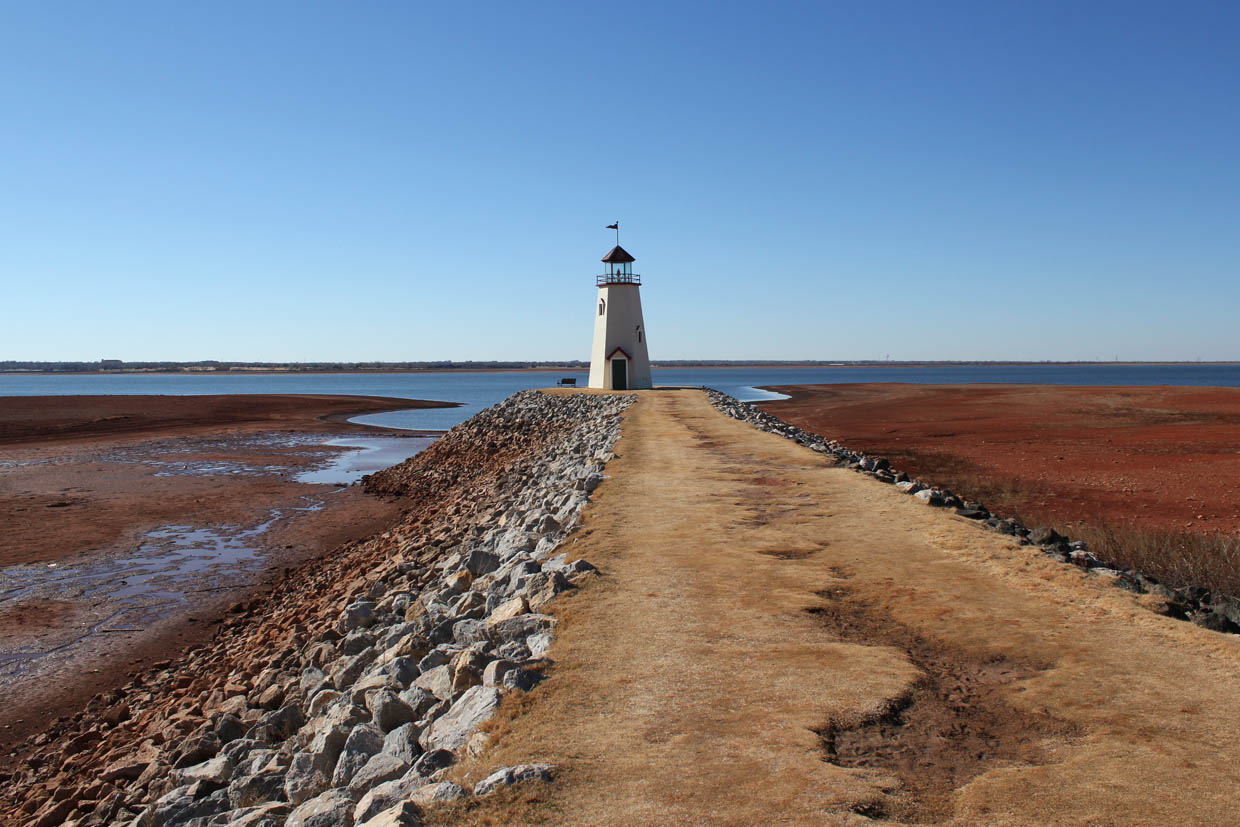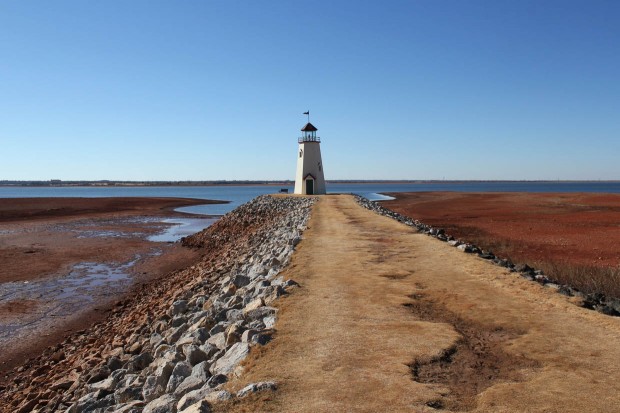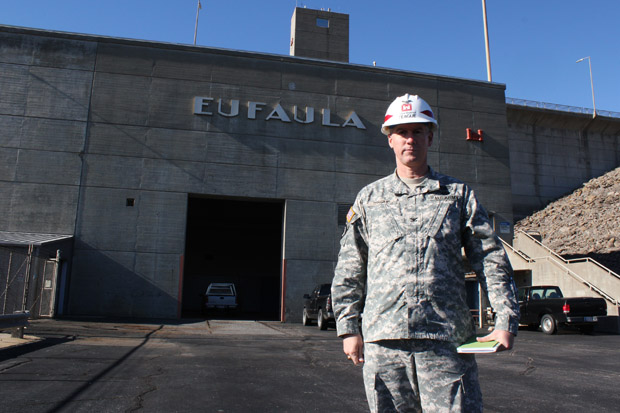
In January, Oklahoma City's Lake Hefner recorded its lowest lake level in its 66-year history.
Joe Wertz / StateImpact Oklahoma


In January, Oklahoma City's Lake Hefner recorded its lowest lake level in its 66-year history.
Joe Wertz / StateImpact Oklahoma

Joe Wertz / StateImpact Oklahoma
In January, Oklahoma City's Lake Hefner recorded its lowest lake level in its 66-year history.
In many ways, the history of Oklahoma is a story of water. Our geography is drawn by rivers and streams. And our cultural legacy is informed by drought.
History, money and consumption have shaped Oklahoma water policy. Here’s a look at the role each part plays in the plan policymakers are writing to protect what former governor and U.S. senator Robert S. Kerr called, the state’s “most blessed resource.”
| Chapter 1: Supply & Demand | Chapter 2: Balancing Act | Chapter 3: Policy & Planning |

Joe Wertz / StateImpact Oklahoma
Col. Michael Teague commands the U.S. Army Corps of Engineers Tulsa District, which includes Lake Eufaula, a lake that illustrates the delicate balance of different water needs.
Creating a statewide water plan hinges on factors Oklahoma can control and elements people have little influence over.
We can’t do much — in the short term — to affect Oklahoma’s climate. Temperature and precipitation patterns are also out of our control. Collectively, these environmental factors can mean less water, which limits economic growth.
And these factors appear to be worsening. The state is suffering a sustained drought. Yang Hong, a climate scientist at the University of Oklahoma, is forecasting a 2-3 degree temperature increase by 2099. Hong’s models show a future Oklahoma with more frequent and longer droughts.
Meanwhile, demand for water is increasing — especially in the agricultural sector. Researchers at the Oklahoma Water Resources Board expect crop irrigation will experience the largest water-demand growth in the next 50 years. And much of Oklahoma’s farming and ranching is located in the driest, most drought-prone parts of the state.
On paper, Oklahoma has a surplus of water. It’s just not located where we need it.
So what can we do?
Storage is one factor we can control. Most of Oklahoma’s reservoirs were built decades ago — during the state’s golden age of lake building. But building new reservoirs is a lot harder than it used to be — and the federal government isn’t writing checks for water projects like it once did.

Joe Wertz / StateImpact Oklahoma
Mitchell Logan supervises a pump station near Macomb, the 100-mile Atoka Pipeline's last stop on its way from southeastern Oklahoma to Oklahoma City's Lake Stanley Draper. OKC has been importing water from southeastern Oklahoma since the 1960s.
While the drought has made the discussion more urgent, the debate over the best way to plan Oklahoma’s water future would be happening without any climatological impetus.
Quite simply, Oklahoma’s water infrastructure is aging and crumbling. Many towns and cities are still using pipes, pumps and treatment equipment installed in the 1930s. And many of these Depression-era water systems are starting to fail.
Infrastructure problems in Oklahoma plague both small towns and big cities.
Konawa is a good example of a small Oklahoma town with very big water problems. In November 2012, water stopped flowing to the city’s 1,300 residents. The likely culprit was decades of sediment that had built up in a section of pipe, City Manager Rita LoPresto told StateImpact. It took four days for service to be restored, and the city still faces millions of dollars more in repairs.
Bigger cities — like Tulsa and Oklahoma City — are in a different position, but still face challenges with long-term water planning. In big cities, the cost of expensive infrastructure upgrades can be spread out over a much larger tax base. But the scale of potential infrastructure problems is much larger. And big cities have the added burden of business and industry, which come with their own water needs and concerns.
Big cities also have more users. Tulsa and Oklahoma City each provide water to about 500,000 customers, and neither city is insulated from other Oklahoma communities. And Oklahoma City, which has a lot fewer surface water resources than its inner-state rival, has a water plan that depends on connections to other regions of the state.
Oklahoma’s City’s plan to use water from southeastern Oklahoma is in jeopardy. In 2011, the Choctaw and Chickasaw Tribes filed a lawsuit against the state claiming they control the water across 22 counties in southeast Oklahoma, not the state. The case is ongoing and being negotiated outside of court, but if the Choctaws and Chickasaws prevail, Oklahoma City would have to go through the tribes to get the water it needs.
Historically, municipalities, businesses, utilities and tribes are the big players when it comes to divvying up the state’s water. But new voices are emerging to fight for users who benefit from a “non-consumptive” use of Oklahoma’s water: tourism. Fishing, boating and recreation mean big money, and groups such as Save Our Water Lake Eufaula have organized to fight efforts that might negatively affect life on and around state lakes and rivers.

Logan Layden / StateImpact Oklahoma
Pennie Embry and Jerry McCormick of Save Our Water Lake Eufaula, a watchdog organization that formed to fight for "non-consumptive" water interests, which includes tourism.
The problems caused by drought and aging water infrastructure aren’t lost on Oklahoma lawmakers.
The state set big goals for itself during the 2012 legislative session by enacting the Oklahoma Water Resources Board’s Comprehensive Water Plan and the Water for 2060 Act, which centers around a conservation goal that Oklahoma consume no more freshwater in 2060 than was consumed in 2012.
The Water for 2060 Act originates in the Comprehensive Water Plan. That water plan also calls for the creation of regional water authorities to oversee planning, an idea that’s had mixed results in other states.
A bill creating the planning groups is moving through the current legislature, as are a number of others focusing on water conservation, including new regulations on mining in aquifers.
But the resistance is heavy. Another bill, by Rep. Paul Wesselhoft, R-Moore, would effectively repeal the Water for 2060 Act. And he’s not the only one who thinks more government means more problems.
Troubled Water, StateImpact’s special on Oklahoma water policy was originally broadcast in February 2013. The full-length audio is available below. It’s 54 minutes long, so we recommend downloading it below or streaming it from here on a mobile device.